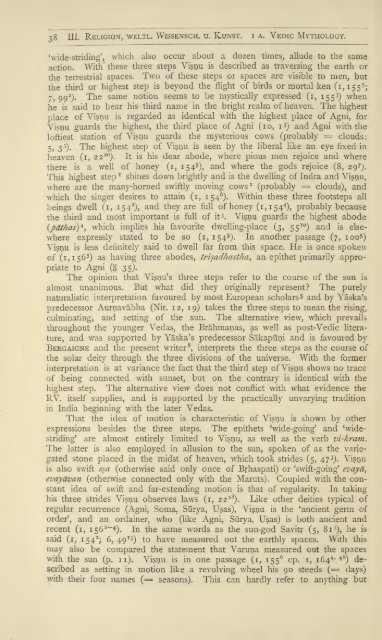Create successful ePaper yourself
Turn your PDF publications into a flip-book with our unique Google optimized e-Paper software.
38 III. RELIGION, WELTL. WISSENSCH. u. KUNST. i A. VEDIC MYTHOLOGY.<br />
wide-striding , which also occur about a dozen times, allude to the same<br />
action. With these three steps Visnu is described as traversing<br />
the terrestrial spaces. Two of these steps or spaces are visible<br />
the earth or<br />
to men, but<br />
the third or highest step is beyond the flight of birds or mortal ken 5<br />
(i,i55 ;<br />
7, 99 2<br />
). The same notion seems to be 3<br />
mystically expressed (i, I55 ) when<br />
he is said to bear his third name in the bright realm of heaven. The highest<br />
place of Visnu is regarded as identical with the highest place of Agni, for<br />
Visnu guards the highest, the third place of Agni (10, i 3 ) and Agni with the<br />
loftiest station of Visnu guards the mysterious cows (probably = clouds:<br />
5, 3 3 ). The highest step of Visnu is seen by the liberal like an eye fixed in<br />
20<br />
heaven (i, 22 ). It is his dear abode, where pious men rejoice and where<br />
there is a well of honey (i, I54 5 ), and where the gods rejoice (8, 297;.<br />
x<br />
This highest step shines down brightly and is the dwelling of Indra and Visnu,<br />
2<br />
where are the many-horned swiftly moving cows (probably = clouds), and<br />
6<br />
which the singer desires to attain (i, i54 ). Within these three footsteps all<br />
beings dwell (x, I54 2<br />
), and they are full of 4<br />
honey (i, i54 ), probably because<br />
the third and most important is full of it 3 . Visnu guards the highest abode<br />
(pdthas)^, which implies his favourite dwelling-place (3, 55 10<br />
) and is else<br />
where expressly stated to be so (i, 15 4 s Visnu is less definitely said<br />
). In<br />
to dwell far from this<br />
another passage (7, ioo5)<br />
space. He is once spoken<br />
of (i,i56 5 ) as having three abodes, trisadhastha, an epithet primarily appro<br />
priate to Agni ($ 35).<br />
The opinion that Visnu s three steps refer to the course of the sun is<br />
almost unanimous. But what did they originally represent? The purely<br />
naturalistic interpretation favoured by most European scholars 5 and by Yaska s<br />
predecessor Aurnavabha (Nir. 12, 19) takes the three steps to mean the rising,<br />
culminating, and setting of the sun. The alternative view, which prevails<br />
throughout the younger Vedas, the Brahmanas, as well as post-<strong>Vedic</strong> litera<br />
ture, and was supported by Yaska s predecessor Sakapuni and is favoured by<br />
BERGAIGNE and the present writer 8<br />
, interprets the three steps as the course of<br />
the solar deity through the three divisions of the universe. With the former<br />
of Visnu shows no trace<br />
interpretation is at variance the fact that the third step<br />
of being connected with sunset, but on the contrary is identical with the<br />
highest step. The alternative view does not conflict with what evidence the<br />
RV. itself supplies, and is supported by the practically unvarying tradition<br />
in India beginning with the later Vedas.<br />
That the idea of motion is characteristic of Visnu is shown by other<br />
expressions besides the three steps. The epithets wide-going and Svidestriding<br />
are almost entirely limited to Visnu, as well as the verb vi-kram.<br />
The latter is also employed in allusion to the sun, spoken of as the varie<br />
gated stone placed in the midst of heaven, which took strides (5, 47 3 ). Visnu<br />
is also swift esa (otherwise said only once of Brhaspati) or swift-going* evaya,<br />
evayavan (otherwise connected only with the Maruts). Coupled<br />
with the con<br />
stant idea of swift and far-extending motion is that of regularity. In taking<br />
his three strides Visnu observes laws (i, 22 l8<br />
). Like other deities typical of<br />
regular recurrence (Agni, Soma, Surya, Usas), Visnu is the ancient germ of<br />
order , and an ordainer, who (like Agni, Surya, Usas) is both ancient and<br />
recent (i, i$6 2<br />
~*). In the same words as the sun-god Savitr (5, 8i 3 ), he is<br />
said (i, I54 1<br />
; 6, 49 13 ) to have measured out the earthly spaces. With this<br />
may also be compared the statement that Varuna measured out the spaces<br />
with the sun (p. n). Visnu is in one passage (i, I55 6<br />
cp. i, 164*- 4b ) de<br />
scribed as setting in motion like a revolving wheel his 90 steeds (= days)<br />
with their four names (= seasons). This can hardly refer to anything but

















